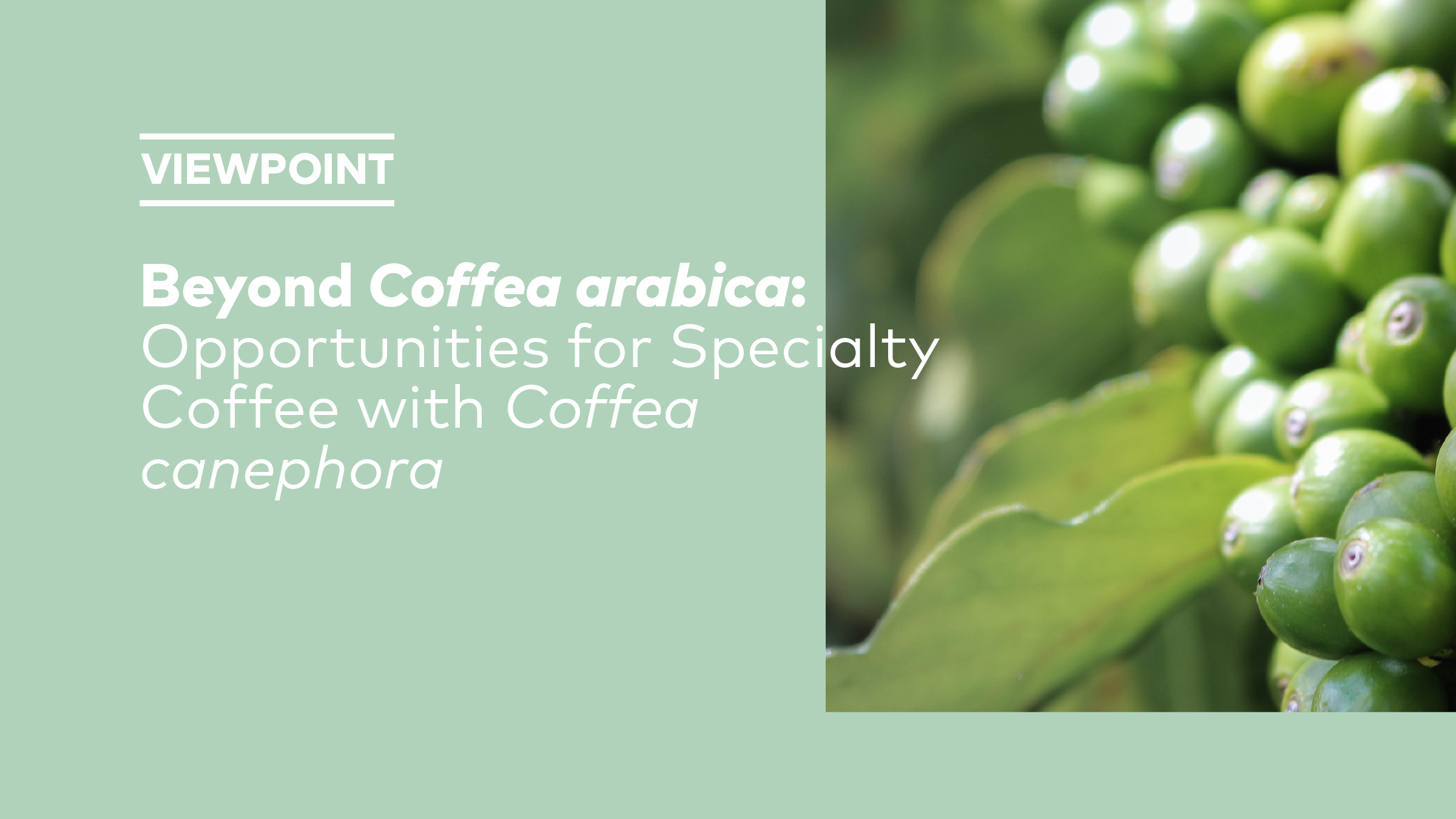Beyond Coffea Arabica: Opportunities for Specialty Coffee with Coffea Canephora
Beyond the current COVID-19 crisis, our industry has known for quite a while that we are facing sustainability issues we need to consider if we want to keep selling specialty coffee in the future.
MARIO FERNÁNDEZ, Technical Director of the Specialty Coffee Association, explores the opportunities of specialty C. canephora.
Our producers, after many years receiving prices below the production cost, lack the resources to face an imminent climate change scenario. Beyond social and economic concerns, there is concern among coffee scientists regarding the slim genetic diversity of the Coffea arabica species which might reduce its resilience against climate change. Also, a slim genetic diversity means fewer opportunities for future differentiation, which is an important issue for an industry that relies on specialty product differentiation. The good news is that some answers to these issues might be found in the parent species of Coffea arabica, Coffea canephora, affectionately known as robusta coffee.[1]
Renewed or new interest in diversity of the coffee genus, whether through the efforts of World Coffee Research in mapping the coffee genome, or with producers and coffee competition competitors interested in different coffee offerings, all point to one idea: C. canephora also deserves a second look, and global warming might bring the opportunity for it to step into the specialty coffee arena. Though some researchers say C. canephora might not adapt well to the conditions of a warmer planet,[2] there are quite a few success stories of low-altitude C. arabica farms with mediocre quality converting to high-quality C. canephora farming. From those farmers’ point of view, it is better and more profitable to produce good C. canephora than bad C. arabica.
Coffea canephora is in fact the parent species of Coffea arabica, together with Coffea eugenoides, and as such, has a much broader genetic diversity than C. arabica. C. canephora is found as a native species in a vast range of habitats, from the Atlantic coast of Equatorial Africa to the high plateau surrounding Lake Victoria, at about 1,000 meters above sea level. This vast genetic bank surely keeps many surprises in terms of cup flavor and quality. However, throughout history, C. canephora coffee varieties have only been bred for crop yield, instant coffee yield, and pest and disease resistance! What would happen if scientists started looking for C. canephora varieties with great cup taste and started breeding and processing for cup quality? It’s likely that C. canephora would taste completely unlike that “robusta flavor” you might have in mind. There is already proof of this cup quality potential: C. canephora varieties grown around Lake Victoria (effectively “high-grown robusta”) can express complexity of both aroma and flavor as well as acidity and sweetness, without the characteristic bitter, salty, and rubbery notes associated with most commercial C. canephora coffees.
The main reason why it is so difficult to find high-quality C. canephora in the market is that it’s kept in a vicious cycle of bad quality. Perceived as a low-quality coffee by the market, the price is kept low, negating C. canephora’s ability to sell as a differentiated product. Without this differentiation, the C. canephora producers who could potentially attain a high-quality product are discouraged to do so: if they strived to produce a high quality C. canephora, their cost would increase yet they would still receive the same low price. For that reason, producers try to keep the cost to a minimum, which results in a continually undifferentiated, low-quality product and further reinforces the perception in the market of robusta being a low-quality product. And so the cycle continues.
However, C. canephora could break free of the cycle in the future; we already have a precedent with natural (dry process) C. arabica coffees over the past decade. After they were displaced by washed coffees along the twentieth century, C. arabica natural coffees were immersed in the same low-quality vicious cycle I just described for C. canephora. However, between 2008 and 2018, natural coffees broke free from that cycle and today it is completely normal and expected to see natural coffees in third wave coffee shops worldwide. Breaking free of the cycle was not easy. It required considerable coordinated effort from many actors in many producing and consuming countries to raise awareness about natural coffee; years of scientific research by various research groups namely in Brazil, Germany, and New Zealand; the inclusion of a natural coffee session in the Q Grader course, and implied training thousands of cuppers in the appreciation of natural coffees. Also key were the inclusion of natural coffees in the World Barista Competition and the extended use of the natural process by the Panama Geisha producers. In short, it did not happen by itself and it did not happen overnight, but the fact that it happened for specialty natural coffees hints at a similar opportunity for specialty C. canephora coffees as well. Raising awareness, developing standards, increasing research, and intensifying education about this species seem to be the way forward for specialty robusta worldwide.
Specialty C. canephora producers are already appearing in several countries and their stories are worth hearing. At the risk of omitting many great producers striving to attain high-quality C. canephora in countries as diverse as Tanzania, Laos, Timor-Leste and the Philippines, I would like to mention Kaweri Coffee Plantation in Uganda, Nishant Gurjer from India, Daniel Piazzini from Brazil, Denise Bustamante from Ecuador, Samuel Coto from Guatemala, Antonio Luttmann from Chiapas, Mexico, and my friends Mónica Gasperín and Abril Solís, from Veracruz, Mexico. A shade-grown C. canephora producer from Tepatlaxco, Mexico (750 masl), Mónica and her partner Abril treat their coffee with more care than most C. arabica producers. Based on the sugar content of the fruit pulp, which they estimate using a refractometer, they mark the trees that will be harvested each day. They give color references specific to each tree to a trained squad of pickers, to ensure the picking of cherries in the required range of ripeness color. Once picked, they again sort their coffee cherries through flotation and decide whether they will make natural or honey coffee based on the weather forecast, the sugar content in the cherry, and the degree of fruit rupture of the batch. They dry their naturals slowly, with a fermentation stage near the end of drying, and they are ready for storage a month and a half of careful drying and fermentation after picking. As a result, their cost is US$2.50/Lb. of green coffee, but the flavor of their coffee is nothing like what most of us know as “robusta flavor”: their coffee is complex, fruity, clean, and sweet, with a mild acidity and a fresh herb note. Abril is trying to sell this coffee to third wave roasters in Mexico City, but as they usually don’t know how to roast C. canephora, she cannot just send them a green coffee sample. She needs to carry out cupping exercises with her potential clients after carefully roasting the samples herself. Abril says she sees a great opportunity in making cold brew from C. canephora, as it has a mild acidity compared to C. arabica; some craft beer brewers are using her cold brew for crafting coffee-flavored beer, without having to deal with excessive sourness. In my opinion, Mónica and Abril are ticking all the boxes of what specialty C. canephora might be, and they represent the forefront of a much larger trend.
Can C. canephora be specialty coffee, then? Without getting into the always prickly matter of defining “specialty coffee,” the Cambridge dictionary defines specialty as “a product that is extremely good in a particular place”—from that point of view, any agricultural product, and particularly complex products such as wine, tea, and coffee, are capable of being “extremely good in a particular place” and thus become specialty. This is certainly true for C. canephora, without question. However, how can we tell if robusta is “extremely good”? Using the same quality criteria we use for C. arabica would be like judging an apricots’ beauty competition with the criteria used to assess the beauty of peaches. Though C. canephora and C. arabica belong to the same genus, they are distinct species, and quality criteria—as for apricots and peaches—need to be specified for robusta.[3]
As we start understanding and defining C. canephora cup quality, we might start to find and develop better-tasting varieties, but we will also need to learn which processing, roasting, and brewing methods are most suitable to this species. Learning how to use C. canephora for specialty coffee will not be a short or easy journey, but it can potentially add new flavors to our industry and —at the same time—help solve some of the current issues faced by C. arabica.
From a coffee producing family in Mexico, MARIO FERNÁNDEZ has tried to understand coffee for 27 years, under the light of food science. He recently joined the SCA as Technical Director.
References
[1] Coffea canephora is also called “conilon” in Brazil.
[2] Bunn et al., “A Bitter Cup: Climate Change Profile of Global Production of Arabica and Robusta Coffee.”
[3] For a great description of how quality can be assessed in robusta coffees vs. arabica coffees, see Ted R. Lingle and Menon, Sunalini N. “Cupping and Grading – Discovering Character and Quality” in The Craft and Science of Coffee, edited by Britta Folmer, Elsevier Academic Press, 2017.

